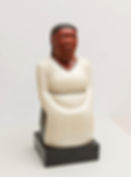top of page
Sargent Claude Johnson
By Andy Brumer
March 13, 2024
Huntington Library and Art Museum, San Marino, California

Sargent Claude Johnson, “Mask,” 1933, copper, 10 7/8 x 7 7/8 x 2 3/8”. Courtesy of the San Francisco Museum of Modern Art. Photo: Don Ross
This exhibition of the mid-twentieth century Modernist sculptor Sargent Claude Johnson (1888-1967) celebrates an artist who worked with dexterous ease across a range of art genres, including masks, portrait busts, figural sculptures, drawings, printmaking, ceramics, painting, enamelwork, and murals. Though small and selective, this first show dedicated to Johnson in over 25 years offers a broad sampling of this protean, empathetic, and underappreciated artist. It will leave you wanting to see more.

Sargent Claude Johnson, “Lovers,” 1935-40. Courtesy of M. Hanks Gallery
Born in Boston to a Swedish American father and an African American mother and orphaned at a young age, Johnson lived for a short time with his uncle and aunt in Washington, D.C. before finishing his education in a Catholic orphanage in Massachusetts. Eventually he would move west, complete his art studies at the California School of Fine Arts (later, the San Francisco Art Institute), where he married and settled with his wife into a Black middle-class neighborhood in Berkeley. By the early 1920’s Johnson was an active and prolific artist whose career was bracketed by The Harlem Renaissance and the Civil Rights era. Throughout his life Johnson never wavered from his primary concern to give a dignified voice to the experiences of Black people.

Sargent Claude Johnson, “Negro Woman,” ca. 1935, paint and wood, 32 x 13 1/2 x 11 3/4”. Courtesy of the San Francisco Museum of Modern Art. Photo: Katherine Du Tiel
The show opens with a series of Johnson’s hand-hammered, delicately rendered, toned, color saturated copper masks. While referencing the stylized aesthetics of African masks, these offer a more sculptural, three-dimensional, and lifelike presence than the masks on which they are modeled, just as they showcase with sensitivity the facial expressions and features of Johnson’s Bay Area African American friends and neighbors. Johnson marked these masks with faint scratches and thinly furrowed ridges, which enhanced their already glowing surfaces. These subtle gestures forge abstract, self-referential “maps.”
A full-figure, painted plaster over linen and wood sculpture, titled “Negro Woman,” falls between assemblage, collage and construction. This kneeling, stocky, earthy woman suggests contemporaneous Modernist Mexican art, especially the work of Diego Rivera, whom Johnson acknowledged as an influence. “Negro Woman” explores the theme of African American motherhood, which Johnson would return to throughout his career.

Sargent Claude Johnson, “Organ Screen,” 1933-34, gilded and painted redwood, 105 x 2364 x 2”. Photo: © 2014 Fredrik Nilsen
The entire exhibition rotates around “Organ Screen,” Johnson’s carved, gilded, and painted redwood bas relief, commissioned in 1934 by the Public Works of Art Project (PWAP) of the New Deal. Designed for the auditorium of the California School for the Blind, then in Berkeley, this impressive architectural installation was the first of several government sponsored commissions. Though the entire screen no longer exists in its entirety, the Huntington has had portions of it in its collection for over a decade. The surviving sections of the screen have been assembled here for the first time in over forty years.
The installation adds up to a California-fashioned “Garden of Earthly Delights,” with its arching woodwork framing gentle woodland animals such foxes, birds, deer and rabbits, a range of sensual flora, a couple of musical instruments and a sprinkling of human faces that radiate and peep out of this bucolic composition like so many disembodied suns. One can imagine amidst such dramatic pulsations the school’s blind student body listening to the rush of the wind, the rippling of a stream, the songs of birds that this screen may have broadcasted to them in metaphorical silence. During the late 1930’s his commission work for the PWAP led Johnson to become one of only three African American national supervisors in the Works Progress Administration (WPA).

Sargent Claude Johnson, “Self Portrait,” 1966, enamel on steel, 17 x 15”.
Courtesy of the San Francisco African American Historical and Cultural Society.
A maquette of a cast stone panel, the final version of which would become became part of a 185-foot-long mural titled “Athletics” (1942) depicting male an female athletes involved in playing a range of Olympic sports, represents Johnson’s last and largest commission from the WPA. The mural still graces the south side of George Washington High School’s football field in San Francisco.

Sargent Claude Johnson working on clay model of “Athletics” sculpture for George Washington High School, November 18, 1940.
A group of small figurative sculptures, made from a range of materials including terracotta, diorite rock, and Oaxaca clay, sit with quiet dignity inside a glass case in the back gallery. The group evokes the Mesoamerican, Egyptian and Pre-Colombian influences on Johnson’s work. Add to these a few dynamic Cubist tempera and enamel on steel paintings (one a self-portrait) that blend African American imagery and color schemes into the quintessentially flat and geometric picture planes of Cubism. Johnson’s body of work offers not only connects the Harlem Renaissance to the Civil Rights eras, but offers a complex of aesthetic bridges between traditional and modernist languages. This was an artist of reconciliation.
Andy Brumer is a poet, book reviewer and art writer, whose work has appeared in The New York Times Book Review, The Los Angeles Times, The San Francisco Chronicle/Examiner, Artweek, Artscene, Visual Art Source and many other publications. His latest book of poetry, with drawings by Joseph Slusky, is Below Understanding. He also writes about golf.
bottom of page

